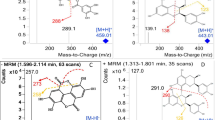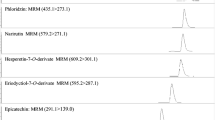Abstract
Recently, search for new natural sources of compounds with health-enhancing properties prompted interest in fruit kernels. This paper aims to assess peach kernels as a source of nutritionally important compounds, such as phenolic compounds. A total of 25 kernels from various peach germplasm differing in origin and ripening time were characterized by their phenolic profiles. Ultra-high-Performance Liquid Chromatography coupled with Linear Trap Quadrupole and OrbiTrap MS/MS hybrid mass spectrometry was used for determination of 76 different organic compounds. The content of identified phenolic compounds indicated peach kernel as reliable source of bioactive substances with prevalent concentrations of catechin and several phenolic acids. Statistical procedures confirm that phenolic compounds could be used as phytochemical biomarkers to differentiate peach kernel samples belonging to different cultivars/genotypes according to their origin and ripening time. The CATPCA confirmed the possibility of application of chemical profiles presented only as categorical variables for classification.

Similar content being viewed by others
References
Bassi D, Monet R (2008) In: Layne D, Bassi D (eds) The peach: botany, production and uses. CABI, London, pp 1–36
FAOStat (2014) http://www.fao.org/faostat/en/#data/QC. Accessed Oct 2017
Vásquez-Villanueva R, Marina ML, García MC (2015) Revalorization of a peach (Prunus persica (L.) Batsch) byproduct: extraction and characterization of ACE-inhibitory peptides from peach stones. J Funct Foods 18:137–146
Stanojević M, Trifković J, Fotirić Akšić M, Rakonjac V, Nikolić D, Šegan S, Milojković-Opsenica D (2015) Sugar profile of kernels as a marker of origin and ripening time of peach (Prunus persicae L.). Plant Food Hum Nutr 70:433–440
Wu H, Shi J, Xue SJ, Kakuda Y, Wang D, Jiang YM, Ye XQ, Li Y, Jayasankar S (2011) Essential oil extracted from peach (Prunus persica) kernel and its physicochemical and antioxidant properties. LWT Food Sci Technol 44:2032–2039
Liu H, Cao J, Jiang W (2015) Evaluation and comparison of vitamin C, phenolic compounds, antioxidant properties and metal chelating activity of pulp and peel from selected peach cultivars. LWT Food Sci Technol 63:1042–1048
Bolarinwa IF, Orfila C, Morgan MRA (2014) Amygdalin content of seeds, kernels and food products commercially-available in the UK. Food Chem 152:133–139
Campbell OE, Padilla-Zakour OI (2013) Phenolic and carotenoid composition of canned peaches (Prunuspersica) and apricots (Prunusarmeniaca) as affected by variety and peeling. Food Res Int 54:448–455
Frolov A, Henning A, Böttcher C, Tissier A, StrackD (2013) An UPLC–MS/MS Method for the simultaneous identification and quantitation of cell wall phenolics in Brassica napus seeds. J Agric Food Chem 61:1219–1227
Ignat I, Volf I, Popa VI (2011) A critical review of methods for characterisation of polyphenolic compounds in fruits and vegetables. Food Chem 126:1821–1835
Guiné RP, Barroca MJ, Gonçalves FJ, Alves M, Oliveira S, Mendes M (2015) Artificial neural network modelling of the antioxidant activity and phenolic compounds of bananas submitted to different drying treatments. Food Chem 168:454–459
Montevecchi G, Vasile Simone G, Mellano MG, Masino F, Antonelli A (2013) Fruit sensory characterization of four Pescabivona, white-fleshed peach [Prunus persica (L.) Batsch], landraces and correlation with physical and chemical parameters. Fruits 68:195–207
Tomás-Barberán FA, Gil MI, Cremin P, Waterhouse AL, Hess-Pierce B, Kader AA (2001) HPLC–DAD–ESIMS analysis of phenolic compounds in nectarines, peaches, and plums. J Agric Food Chem 49:4748–4760
Zupan A, Mikulic-Petkovsek M, Cunja V, Stampar F, Veberic R (2013) Comparison of phenolic composition of healthy apple tissues and tissues affected by bitter pit. J Agric Food Chem 61:12066–12071
Aaby K, Ekeberg D, Skrede G (2007) Characterization of phenolic compounds in strawberry (Fragaria x ananassa) fruits by different HPLC detectors and contribution of individual compounds to total antioxidant capacity. J Agric Food Chem 55:4395–4406
Vallverdú-Queralt A, Regueiro J, Martínez-Huélamo M, de Alvarengam JF, Leal LN, Lamuela-Raventós RM (2014) A comprehensive study on the phenolic profile of widely used culinary herbs and spices: rosemary, thyme, oregano, cinnamon, cumin and bay. Food Chem 154:299–307
Noratto G, Martino HSD, Simbo S, Byrne D, Mertens-Talcott SU (2015) Consumption of polyphenol-rich peach and plum juice prevents risk factors for obesity-related metabolic disorders and cardiovascular disease in Zucker rats. J Nutr Biochem 26:633–641
Lucci P, Saurina J, Núñez O (2017) Trends in LC–MS and LC–HRMS analysis and characterization of polyphenols in food. Trends Anal Chem 88:1–24
Liu H, Cao J, Jiang W (2015) Changes in phenolics and antioxidant property of peach fruit during ripening and responses to 1-methylcyclopropene. Postharvest Biol Technol 108:111–118
Hurtado-Fernández E, Gómez-Romero M, Carrasco-Pancorbo A, Fernández-Gutiérrez A (2010) Application and potential of capillary electroseparation methods to determine antioxidant phenolic compounds from plant food material. J Pharm Biomed 53:1130–1160
Naczk M, Shahidi F (2006) Phenolics in cereals, fruits and vegetables: occurrence, extraction and analysis. J Pharm Biomed 41:1523–1542
Falcão SI, Vilas-Boas M, Estevinho LM, Barros C, Domingues MRM, Cardoso SM (2010) Phenolic characterization of Northeast Portuguese propolis: usual and unusual compounds. Anal Bioanal Chem 396:887–897
Kečkeš S, Gašić U, Ćirković Veličković T, Milojković-Opsenica D, Natić M, Tešić Ž (2013) The determination of phenolic profiles of Serbian unifloral honeys using ultra-high-performance liquid chromatography/high resolution accurate mass spectrometry. Food Chem 138:32–40
Mudrić S, Gašić U, Dramićanin A, Ćirić I, Milojković-Opsenica D, Popović-Đorđević J, Momirović N, Tešić Ž (2017) The polyphenolics and carbohydrates as indicators of botanical and geographical origin of Serbian autochthonous clones of red spice paprika. Food Chem 217:705–715
Lamuela-Raventós RM, Vallverdú-Queralt A, Jáuregui O, Martínez-Huélamo M, Quifer-Rada P (2014) In: Watson RR (ed) Polyphenols in plants: isolation, purification and extract preparation. Elsevier Inc, London, pp 261–283
Bakić I, Rakonjac V, Čolić S, Fotirić Akšić M, Nikolić D, Radović A, Rahovića D (2017) Agro-morphological characterisation and evaluation of a Serbian vineyard peach [Prunus persica (L.) Batsch] germplasm collection. Sci Hortic 225:668–675
Vujanić-Varga D, Ognjanov V (1992) Conservation of vineyard peach populations in Yugoslavia. FAO IBPGR Plant Genet Resour Newsl 90:28–30
Prodanov M, Garrido I, Vacas V, Lebrón-Aguilar R, Dueñas M, Gómez-Cordovés C, Bartolomé B (2008) Ultrafiltration as alternative purification procedure for the characterization of low and high molecular-mass phenolics from almond skins. Anal Chim Acta 609:241–251
Vallverdú-Queralt A, de Alvarenga JF, Estruch R, Lamuela-Raventós RM (2013) Bioactive compounds present in the Mediterranean sofrito. Food Chem 141: 3365–3372
Plazonić A, Bucar F, Maleš Ž, Mornar A, Nigović B, Kujundžić N (2009) Identification and quantification of favonoids and phenolic acids in Burr Parsley (Caucalis platycarposL.), using high-performance liquid chromatography with diode array detection and electrospray ionization mass spectrometry. Molecules 14:2466–2490
Chen S-D, Lu C-J, Zhao R-Z (2015) Identification and quantitative characterization of PSORI-CM01, a Chinese medicine formula for psoriasis therapy, by liquid chromatography coupled with an LTQ Orbitrap mass spectrometer. Molecules 20:1594–1609
Castro C, Mura F, Valenzuela G, Figueroa C, Salinas R, Zuñiga CM, Torres JL, Fuguet E, Delporte C (2014) Identification of phenolic compounds by HPLC–ESI–MS/MS and antioxidant activity from Chilean propolis. Food Res Int 64:873–879
Gu D, Yang Y, Abdulla R, Aisa HA (2012) Characterization and identification of chemical compositions in the extract of Artemisia rupestris L. by liquid chromatography coupled to quadrupole time-of-flight tandem mass spectrometry. Rapid Commun Mass Spectrom 26:83–100
Khallouki F, Haubner R, Erben G, Ulrich CM, Owen RW (2012) Phytochemical composition and antioxidant capacity of various botanical parts of the fruits of Prunus × domestica L. from the Lorraine region of Europe. Food Chem 133:697–706
Ristivojević P, Trifković J, Gašić U, Andrić F, Nedić N, Tešić Ž, Milojković-Opsenica D (2015) Ultrahigh-performance liquid chromatography and mass spectrometry (UHPLC–LTQ/Orbitrap/MS/MS) study of phenolic profile of Serbian poplar type propolis. Phytochem Anal 26:127–136
Zhao T, He J, Wang X, Ma B, Wang X, Zhang L, Li P, Liu N, Lu J, Zhang X (2014) Rapid detection and characterization of major phenolic compounds in Radix Actinidia chinensis Planch by ultra-performance liquid chromatography tandem mass spectrometry. J Pharm Biomed 98:311–320
Álvarez-Fernández MA, Hornedo-Ortega R, Cerezo AB, Troncoso AM, García-Parrilla MC (2016) Determination of nonanthocyanin phenolic compounds using high-resolution mass spectrometry (UHPLC–Orbitrap–MS/MS) and impact of storage conditions in a beverage made from strawberry by fermentation. J Agric Food Chem 64:1367–1376
Martins N, Barros L, Santos-Buelga C, Henriques M, Silva S, Ferreira ICFR (2015) Evaluation of bioactive properties and phenolic compounds in different extracts prepared from Salvia officinalis L. Food Chem 170:378–385
Vallverdú-Queralt A, Jáuregui O, Medina-Remón A, Andrés-Lacueva C, Lamuela-Raventós RM (2010) Improved characterization of tomato polyphenols using liquid chromatography/electrospray ionization linear ion trap quadrupole Orbitrap mass spectrometry and liquid chromatography/electrospray ionization tandem mass spectrometry. Rapid Commun Mass Spectrom 24:2986–2992
Spínola V, Pinto J, Castilho PC (2015) Identification and quantification of phenolic compounds of selected fruits from Madeira Island by HPLC–DAD–ESI–MSn and screening for their antioxidant activity. Food Chem 173:14–30
Barros L, Dueñas M, Ferreira ICFR, Carvalho AM, Santos-Buelga C (2011) Use of HPLC–DAD–ESI/MS to profile phenolic compounds in edible wild greens from Portugal. Food Chem 127:169–173
Sanz M, Cadahía E, Esteruelas E, Muñoz ÁM, Fernández de Simón B, Hernández T, Estrella I (2010) Phenolic compounds in chestnut (Castanea sativa Mill.) heartwood. Effect of toasting at cooperage. J Agric Food Chem 58:9631–9640
Rawat MSM, Prasad D, Joshi RK, Pant G (1999) Proanthocyanidins from Prunus armeniaca roots. Phytochemistry 50:321–324
Vrhovsek U, Masuero D, Palmieri L, Mattivi F (2012) Identification and quantification of flavonol glycosides in cultivated blueberry cultivars. J Food Compos Anal 25:9–16
Sandín-España P, Mateo-Miranda M, López-Goti C, De Cal A, Alonso-Prados JL (2016) Development of a rapid and direct method for the determination of organic acids in peach fruit using LC–ESI–MS. Food Chem 192:268–273
Caretto S, Linsalata V, Colella G, Mita G, Lattanzio V (2015) Carbon Fluxes between primary metabolism and phenolic pathway in plant tissues under stress. Int J Mol Sci 16:26378–26394
Pant BD, Pant P, Erban A, Huhman D, Kopka J, Scheible WR (2015) Identification of primary and secondary metabolites with phosphorus status-dependent abundance in Arabidopsis, and of the transcription factor PHR1 as a major regulator of metabolic changes during phosphorus limitation. Plant Cell Environ 38:172–187
Nunes-Damaceno M, Muñoz-Ferreiro N, Romero-Rodríguez MA, Vázquez-Odériz ML (2013) A comparison of kiwi fruit from conventional, integrated and organic production systems. LWT Food Sci Technol 54:291–297
Acknowledgements
This work has been supported by the Ministry of Education, Science and Technological Development of Serbia, Grant nos. 172017 and TR 31063. The authors wish to thank Mr. Gordan Zec for selection of peach cultivars/genotypes.
Author information
Authors and Affiliations
Corresponding author
Ethics declarations
Conflict of interest
The authors declared that they have no conflict of interest to this work.
Compliance with ethics requirements
This article does not contain any studies with human or animal subjects.
Electronic supplementary material
Below is the link to the electronic supplementary material.
Rights and permissions
About this article
Cite this article
Koprivica, M.R., Trifković, J.Đ., Dramićanin, A.M. et al. Determination of the phenolic profile of peach (Prunus persica L.) kernels using UHPLC–LTQ OrbiTrap MS/MS technique. Eur Food Res Technol 244, 2051–2064 (2018). https://doi.org/10.1007/s00217-018-3116-2
Received:
Revised:
Accepted:
Published:
Issue Date:
DOI: https://doi.org/10.1007/s00217-018-3116-2




